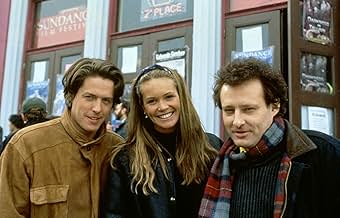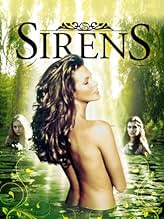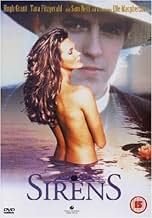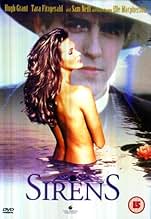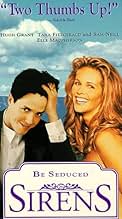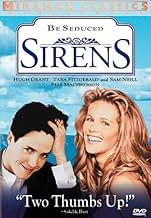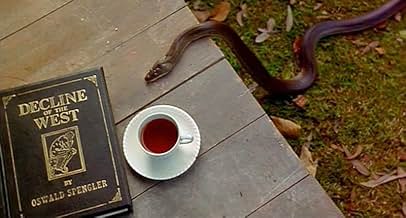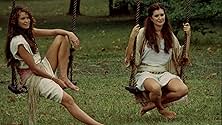CALIFICACIÓN DE IMDb
5.9/10
12 k
TU CALIFICACIÓN
Cuando una pintura es calificada de blasfema, un joven ministro y su esposa visitan al artista, y a las tres modelos sexualmente juguetonas que viven con él.Cuando una pintura es calificada de blasfema, un joven ministro y su esposa visitan al artista, y a las tres modelos sexualmente juguetonas que viven con él.Cuando una pintura es calificada de blasfema, un joven ministro y su esposa visitan al artista, y a las tres modelos sexualmente juguetonas que viven con él.
- Dirección
- Guionista
- Elenco
- Premios
- 1 premio ganado y 4 nominaciones en total
Tziporah Malkah
- Pru
- (as Kate Fischer)
- Dirección
- Guionista
- Todo el elenco y el equipo
- Producción, taquilla y más en IMDbPro
Opiniones destacadas
I personally believe this film is "so" subtle that it cruises under the scope of the average person - no insult intended! So many say they "liked this film but..." just goes to show how subtle this film really is. The photography is absolutely breathtaking. Film stills would make such a collage - oy! The acting is so right on and precise from each and every actor - the characters so well defined. The story is so exquisitely told...! During the whole movie, I kept expecting that statue (you know the one!) to take off walking. At the end, in the dream sequence when the statue stepped down from her pedestal and walked off into the mist, it nearly blew my mind! The way the story switches back & forth between conscious & unconscious day-to-day experiences so seamlessly amazes me. I fell totally in love w/this movie. I went thru a stage of watching it at least once a day for about 1 1/2 years - almost w/out fail! I am married to an artist. I have been his model. I am a woman. This film speaks to these matters with such clarity it's truly amazing. The transition Tara Fitzgerald's character goes thru in waking up to her womanhood is also an integral and major part of the story. The symbolism of the painting of the dual woman - and her being awakened each night by something in the natural/instinctive world calling her to consciousness. Lucid dreaming - becoming conscious thru internal knowledges calling forth her true nature. Please forgive me for not writing in complete proper syntax. I'm usually much better at expressing myself than this. But my relationship with this film is so very personal as to be abstract in tho't. Plus, I've never tried to express my feelings about "Sirens" before. I am almost shocked when I read that some of you think it was less than a "10"! "Predictable"?! Maybe you are more on the ball than I am and than I am giving you credit for. Pardon me please! This is "one" of the all time best movies ever - for me anyway! And - really! - when the preacher & his wife arrive - one of the first people to greet them on their mission is the old fella on the car bumper with,"Get f***ed!" Ya gotta love that!
I knew nothing about this movie, but offered to accompany a woman I had known for some time, but had never been on more than vaguely friendly terms. I was not prepared for the charm, playfulness, joy and raw sensuality that this film captured. Sam Neill is the ultimate sensualist, yet indulges his children's fancies with innocent abandon. Hugh Grant is a likable doofus, and he is far outpaced by Tara Fitzgerald's acceptance of the pleasures of the flesh. In many ways, this couple reminded me of Brad & Janet in "Rocky Horror" - the man is either unable or too clueless to accept the sensual awakening that his companion does. Thus, I was pleased at my date's choice of film, and any discomfort of my own at being seduced by the screen on a first date soon passed from my date's reactions to the sexy scenes. On the anniversary of that date, I paid the outrageous price of $59.95 for a VHS copy, and the repeat viewings were as pleasant as th first. We later married, and this was her idea, too.
P.S.: I recommend "The Advocate" for those who like "Sirens".
P.P.S.: I agree for the most part with Eamon Buchanan's comments, but, the models were "painted"in the nude, not "painting", and it was the Anglican church that was upset, not the Catholic (the Campions could not have been married if they were Catholic).
P.S.: I recommend "The Advocate" for those who like "Sirens".
P.P.S.: I agree for the most part with Eamon Buchanan's comments, but, the models were "painted"in the nude, not "painting", and it was the Anglican church that was upset, not the Catholic (the Campions could not have been married if they were Catholic).
"Sirens" seems to have touched a nerve here. Some reviewers dismiss it as derivative soft-core drivel. Others love it. It probably helps to know that there's little derivative about the story-it's based on real people and a real incident. Sam Neill's character--Norman Lindsay--was real. Lindsay, a prolific artist and novelist, was also a libertine living a Hugh Hefner lifestyle when the rest of the world was awakening from the Victorian Age. "Sirens" was filmed at the Lindsay home and gallery, a 40-acre estate now run by the Australian National Trust. The artworks are all Lindsay's. And the storyline is based on an incident in which the Anglican Church dispatched a cleric to convey concerns about "The Crucifixion of Venus." As for the plot, it's simply a humorous retelling of what might have been--with lots of voluptuous nudes and erotic symbolism tossed in for good measure. Yes, it's all quite predictable. You know five minutes into the film that the Converters will become the Converted. But it's a fun ride getting to that inevitable destination. `Sirens' is not for everyone. If full-frontal male and female nudity offends, you will be offended. If ridiculing the Church or its values offends, you will be offended. And if the notion that the cure for a boring marriage is a little extra-marital dalliance offends, you will truly be offended. Otherwise, it's a little erotic gem and a great way to start an even better evening. :)
While this film is often not taken seriously because of its explicit nudity, it is in fact one of the most thought-provoking commentaries on religious values I have ever seen on the screen. This film provides us with the stark contrast of the repressed preacher from London and the artist's three models in rural Australia, a throwback to Shakespeare's "Green World." The fulcrum of this contrast is the preacher's wife, being pulled in both the oppressive, "moral" direction by her upbringing and her husband and the free and expressive direction of the artist. The breathtaking cinematography and stunning visual symbolism of this film contribute to make it into a powerful attack on the Christian moral code that dominates western thinking. I have been scoffed at on more than one occasion for praising Sirens, but I left the theater questioning my own views about what is and is not moral. The fact that this film's sexual content seems to invalidate it as art in many people's eyes merely underscores the value of its message. Along with Sling Blade, Sirens to me stands as the most provocative film about morality made in the 1990's. A solid 8 on a scale of 1 to 10.
I absolutely love this truly erotic film. An exploration of the awakening of a woman's sexuality, it is beautifully filmed and acted, and has many moments of wit and humour.
Some reviewers object to the heavily laden symbolism attributed to various parts, such as the shots of the snake. Well, symbolism is part of what good writers refer to as "subtext", it isn't too often seen these days, and is at least part of an attempt to have the film say more than what the characters say to each other. This is an artistically valid thing for any film to do, and raises the level of film culture generally, if only a little.
I have yet to see anyone commenting on the superb score - this wonderful music by Rachel Portman (whose work I otherwise do not know) is a delight from start to finish, and unlike most movie music, would stand on its own as a concert piece. The main theme, quirky, cheerful and rhythmically very interesting, seems to take as its inspiration the Vaughan Williams "March of the Kitchen Utensils" heard at the very start of the film as we follow Hugh Grant's feet walking through the art gallery, but it is very much an excellent piece of music in its own right. The "Dream Variations" are suitably dreamy, and coupled with the slow motion photography make for a superb piece of cinema.
John Duigan (writer, director) is not often mentioned in the same breath as other well known Australian directors such as George Miller or Peter Weir or Bruce Beresford, but personally I think he stands up with the best of them. A true Auteur (he has scripted most of the films he has directed) his films are always very interesting character studies. A more well known recent film he made was "The Leading Man" which starred Jon Bon Jovi as an American actor who comes to London to appear in a West End Play, and is "hired" by the director to seduce his wife. As in The Leading Man, Sirens is about the interactions between characters, this providing in my view more than enough in the way of plot and sub-plot. If Duigan's films always seem to be about human sexuality, well, after all, that is what drives most human relationships, whether we want to admit it or not. I think what stands out about Duigan's films, and particularly about Sirens, is their total honesty about human sexuality, without (and I know some will disagree) being excessively prurient.
A final line - I love the helicopter shot at the very, very end of the film. It is a beautiful, painterly landscape scene (which fades out *just* too soon), but one's love of its beauty is strengthened by one's admiration of the five actresses, who had to climb to the top of this sheer-looking rocky outcrop and remove all their clothes for the shot! They have my appreciation, and my sympathy!
Some reviewers object to the heavily laden symbolism attributed to various parts, such as the shots of the snake. Well, symbolism is part of what good writers refer to as "subtext", it isn't too often seen these days, and is at least part of an attempt to have the film say more than what the characters say to each other. This is an artistically valid thing for any film to do, and raises the level of film culture generally, if only a little.
I have yet to see anyone commenting on the superb score - this wonderful music by Rachel Portman (whose work I otherwise do not know) is a delight from start to finish, and unlike most movie music, would stand on its own as a concert piece. The main theme, quirky, cheerful and rhythmically very interesting, seems to take as its inspiration the Vaughan Williams "March of the Kitchen Utensils" heard at the very start of the film as we follow Hugh Grant's feet walking through the art gallery, but it is very much an excellent piece of music in its own right. The "Dream Variations" are suitably dreamy, and coupled with the slow motion photography make for a superb piece of cinema.
John Duigan (writer, director) is not often mentioned in the same breath as other well known Australian directors such as George Miller or Peter Weir or Bruce Beresford, but personally I think he stands up with the best of them. A true Auteur (he has scripted most of the films he has directed) his films are always very interesting character studies. A more well known recent film he made was "The Leading Man" which starred Jon Bon Jovi as an American actor who comes to London to appear in a West End Play, and is "hired" by the director to seduce his wife. As in The Leading Man, Sirens is about the interactions between characters, this providing in my view more than enough in the way of plot and sub-plot. If Duigan's films always seem to be about human sexuality, well, after all, that is what drives most human relationships, whether we want to admit it or not. I think what stands out about Duigan's films, and particularly about Sirens, is their total honesty about human sexuality, without (and I know some will disagree) being excessively prurient.
A final line - I love the helicopter shot at the very, very end of the film. It is a beautiful, painterly landscape scene (which fades out *just* too soon), but one's love of its beauty is strengthened by one's admiration of the five actresses, who had to climb to the top of this sheer-looking rocky outcrop and remove all their clothes for the shot! They have my appreciation, and my sympathy!
¿Sabías que…?
- TriviaAlthough this is a work of fiction, it is about a real person. Norman Lindsay was a real-life artist and author in Australia during the early 1900s. Several of his books have been adapted into movies, including Corazones en fuga (1969).
- ErroresThe beautiful green steam locomotive that is seen in an early scene is a NSWGR 38 class, which first entered service in 1942. ( the movie is set around the year 1930. )
- Citas
Sheela: [Anthony has just gone to the outhouse] I should have warned him about the redbacks.
Estella Campion: What are they?
Sheela: Small spiders with big teeth. They live under toilet seats usually.
Estella Campion: How do you know if they're there?
Sheela: By the screams.
- Créditos curiososThe situations depicted in this film are fictitious and do not represent events in the lives of Rose, Norman, Jane and Honey Lindsay.
- Versiones alternativasAccording to the Technical Specifications link for this page on IMDB, there are two different versions of this film: "1 hr 38 min (98 min)," and "1 hr 34 min (94 min) (Canada)."
- ConexionesEdited from A Steam Train Passes (1974)
- Bandas sonorasGrey Funnel Line
Written by Cyril Tawney
Dick James Music, Ltd.
Performed by Silly Sisters
Courtesy of Chrysalis Records, Ltd.
Selecciones populares
Inicia sesión para calificar y agrega a la lista de videos para obtener recomendaciones personalizadas
- How long is Sirens?Con tecnología de Alexa
Detalles
Taquilla
- Total en EE. UU. y Canadá
- USD 7,770,731
- Fin de semana de estreno en EE. UU. y Canadá
- USD 34,299
- 6 mar 1994
- Total a nivel mundial
- USD 7,770,731
Contribuir a esta página
Sugiere una edición o agrega el contenido que falta



